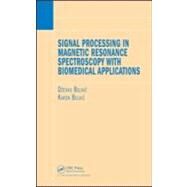- ISBN: 9781439806449 | 1439806446
- Cover: Hardcover
- Copyright: 1/29/2010
Uses the FPT to Solve the Quantification Problem in MRS An invaluable tool in non-invasive clinical oncology diagnosticsAddressing the critical need in clinical oncology robust and stable signal processing in magnetic resonance spectroscopy (MRS), Signal Processing in Magnetic Resonance Spectroscopy with Biomedical Applications explores cutting-edge theory-based innovations for obtaining reliable quantitative information from MR signals for cancer diagnostics. By defining the natural framework of signal processing using the well-established theory of quantum physics, the book illustrates how advances in signal processing can optimize MRS.The authors employ the fast Padé transform (FPT) as the unique polynomial quotient for the spectral analysis of MR time signals. They prove that residual spectra are necessary but not sufficient criteria to estimate the error invoked in quantification. Instead, they provide a more comprehensive strategy that monitors constancy of spectral parameters as one of the most reliable signatures of stability and robustness of quantification. The authors also use Froissart doublets to unequivocally distinguish between genuine and spurious resonances in both noise-free and noise-corrupted time signals, enabling the exact reconstruction of all the genuine spectral parameters. They show how the FPT resolves and quantifies tightly overlapped resonances that are abundantly seen in MR spectra generated using data from encoded time signals from the brain, breast, ovary, and prostate.Written by a mathematical physicist and a clinical scientist, this book captures the multidisciplinary nature of biomedicine. It examines the remarkable ability of the FPT to unambiguously quantify isolated, tightly overlapped, and nearly confluent resonances.







